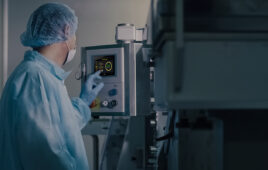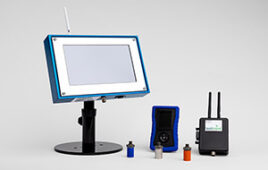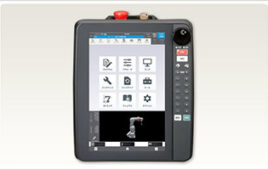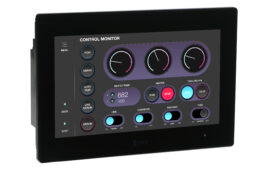Edited by Kathryn Tomiello, Staff Editor
Operator interface terminals are known by many names, such as human machine interfaces (HMIs), man machine interfaces (MMIs), operator panels, and industrial computers. Unlike personal-grade computers, however, these industrial devices can withstand high levels of shock, vibration, temperature variation, and fluid and chemical use. Whether you are choosing a rugged device for use on the factory floor, in vehicles, or out in the elements, consideration of specific criteria will ensure optimum operation in your application.

For in-vehicle applications where ambient light constantly changes, a terminal with an ambient light sensor is recommended so the user is not continually adjusting the display lighting.
One of the first criteria is the type of interface display and how it uses light. Liquid crystal displays (LCD) have transparent electrodes printed on the insides of two separate pieces of glass. On the outside of each piece of glass are polarizers, and in between the glass is a special fluid called liquid crystal. Most LCDs use an organic type of liquid crystal called twisted nematic (TN) or a variation called super twisted nematic (STN). The liquid crystal fluid aligns itself when an electric field is present and blocks the light passing through the LCD; this is known as the “on” state, and the element appears dark. When no electric field is present, the fluid lines up with special grooves in the glass and light can pass through the LCD; this is known as the “off” state.

By selectively applying voltage to the electrodes on the glass, a pattern of “on” and “off” elements will produce the characters or graphics seen on LCDs.
LCDs are a passive display technology, meaning they do not emit light, but rather use ambient light or require some other light source. These devices are much smaller and lighter, and consume very little power compared to other display technologies, such as vacuum florescent displays (VFD), electro luminescent displays (EL), or cathode ray tubes (CRT).
The various types of LCD displays each have advantages and disadvantages. Whether a particular type will operate in your environment depends on the inherent display contrast, whether sunlight is directly hitting the display, its angle with respect to the viewer, and the type and effectiveness of any anti-reflective coatings.
Terminals use reflective, transmissive or transflective sources for light. Ambient light is considered reflective, an internal backlight is transmissive, or a combination of both reflected and transmitted light is viewed as transflective.
In a reflective display, ambient light passes through the LCD glass layers and reflects light off of a mirrored surface at the back of the display. These types of displays are usually the least expensive and are excellent for brightly lit or sunlit areas, but difficult or impossible to read in dim lighting.
A transmissive display uses a backlight behind the LCD to produce light that shines through the display. A terminal using this method is ideal for dim or dark environments, but appears washed out when ambient light is bright, and is almost
impossible to view in sunlight.
A transflective LCD offers the best visibility over a range of lighting conditions. However, it generally does not provide as high a contrast as reflective displays under bright ambient light or as transmissive displays in dark conditions.

A transreflective LCD is a combination of a reflective and transmissive display using a partially reflective mirror and a backlight. The partial mirror reflects some of the ambient light, but it also lets some of the light from the backlight pass through. An “off” element has light from the backlight and reflected light from the mirror passing through it. An “on” element blocks the light and appears dark.
LED backlights are low-voltage devices, are nearly impervious to shock and vibration, and have almost unlimited life. They can be made fairly bright, but since they are spot sources, they depend on various types of diffusers to spread the light out evenly, which increases the thickness of the display.
Cold cathode florescent lights (CCFL) are most commonly used in larger displays. They can be made very bright, and because they are line sources rather than point sources, it is easier to diffuse their light over a plane. However, as with EL backlights, they require special high-voltage circuitry; their half-life is typically 30,000 to 50,000 hours; and, unlike either EL or LEDs, they are made of glass and can break. Finally, when made very bright, they generate heat, which must be accounted for in the engineering design.
Assuring brightness
The brightness of the display’s backlight plays a major role in how visible the display is in bright ambient light. Types of backlighting include: electroluminescent (EL), light-emitting diode (LED), and cold-cathode florescent tube (CCFL).
In electroluminescent methods, illumination is even across the entire display. The backlight itself is thin and can produce light in a variety of colors. These displays are impervious to shock. However, they require a high-voltage AC power supply (typically around 400 V); they cannot be made as bright as sunlight-readability generally requires; and they use phosphors that degrade over time, giving a typical life of 15,000 to 30,000 hours.
Creating contrast
Several technologies are used to drive individual pixels of the display. The best technologies increase the contrast of individual pixels, making the display appear sharper and colors brighter. In order of increasing display quality (and usually increasing price) are twisted nematic, supertwist nematic, and thin film transistor.
Twisted Nematic (TN) would include all watches, LCD clock displays, and custom displays in small handheld instruments. When the pixel count gets large, especially in graphic displays, the required multiplexing of pixel voltages degrades the contrast to the point of being unusable.
SuperTwist Nematic (STN) is similar to TN, but improved fluids provide good contrast at much higher multiplexing ratios. STN-fluid displays are useful for roughly QVGA resolutions (320×240), with up to about 4,000 colors, depending on the LCD controller.
TN and STN LCD displays use a passive matrix driving-scheme. Only one row of pixels is actively driven at a time. Relative to active matrix technologies, passive displays have a more limited viewing angle and a slower response time, making them unsuitable for displaying video streams.
Thin Film Transistor (TFT) displays are an active matrix technology where each individual pixel is controlled by one to four transistors. In active matrices, all pixels are driven simultaneously. TFT displays have brighter, more vivid colors, a larger color range, a wider viewing angle, and a faster response time, which make them suitable for displaying videos. TFTs usually cost more than passive alternatives and require a more complex LCD controller circuit to drive the display.
Touch communication
Most operator interface terminals have some way for the operator to communicate with the machine, typically with touch screens and keypads. These components are used to enter set points, change values, and to stop and start processes.

Touch screens come in many different varieties. Which type you select will depend upon your application.
Resistive touch screens are the most common type of screens. They sense touch through either fingers or styli making contact between two resistive film patterns on a flexible material, usually plastic film. However, the resistive films and spacer dots used to separate the films can compromise their transparency and contrast. Plus, they scratch easily and can wear out from repeated touches. Sharp objects can damage them as well.
Capacitive touch panels sense the change of capacitance between conductors in the panel and an object, specifically a non-gloved finger or a metallic stylus. They, too, have disadvantages. Conductive films or fine wires in the screen compromise transparency and contrast, and accuracy is jeopardized by moisture on the touch surface. Accuracy is also at somewhat dependent on the electrical characteristics of the surrounding environment. Additionally, the surface must be made of a non-conductive material, such as glass or plastic.
Projected capacitance touch screens use a pattern of conductors in the screen to sense changes in capacitance. The conductor pattern controls the electric field near the screen to enhance operation. They work with either a finger or metallic stylus. Conductive films or fine wires compromise transparency and contrast, and moisture on the touch surface also affects accuracy. However, these types have no wear out mechanisms.
Surface acoustic wave touch screens detect the disturbance of ultrasonic acoustic waves traveling on the front surface of the touch screen. Advantages include: the touch surface can be rugged; there is no wear out mechanism; they will sense any object; and they work over wide temperature extremes. However, the touch surface must be made of glass, and it is sensitive to foreign material and scratches. It may also be difficult to seal the terminal against the elements.
Guided Acoustic Wave touch screens detect the disturbance of ultrasonic acoustic waves traveling though the bulk of the screen. The touch surfaces can be rugged, and they do not wear out. However, the touch surface must be made of glass and is sensitive to foreign material.
Dispersive Signal Technology recognizes touch by interpreting bending waves created in the touch screen through the impact of touch from any sort of stylus, fingers, or gloves. Transducers on the screen receive the vibrations from the touch. The device then processes them to determine the location. The touch surface can be very rugged. It is much less
sensitive to scratches and foreign material than other acoustic wave technologies. However, mounting and calibration can be difficult.
Infrared touch screens work with infrared touch sensors, which are contained within a frame surrounding the touch area. They sense when the light beams are interrupted. The touch surface can be of any material since it is not involved in the sensing. The surface will work with any touch object. These screens can be very rugged and operate over wide temperature extremes. Additionally, the touch surface does not actually have to be touched. Some infrared touch sensors can detect simultaneous touches. Infrared touch screens are sensitive to dirt, moisture, or other foreign materials on the touch screen that block or scatter the light beams. They are also sensitive to dirt and foreign materials on the frame.
Hit the keys
A membrane-without-dome keypad has two pieces of polyester with conductive ink, separated by a thin (about 0.2 mm) spacer; and is common in consumer electronics like
microwave ovens, washing machines, and so forth.
A membrane-poly-dome keypad consists of two pieces of plastic or polyester with conductive ink painted on the underside of the dome and the plastic backer. When the dome is collapsed, the conductive ink on the underside of the dome comes in contact with the ink on the backer and makes a connection or “key press.” These inputs have several advantages: the keypad construction is inexpensive; they can be sealed against the elements; and LEDs can be embedded in them.

Because they can be made water-tight, have the option of embedded LEDs, and are inexpensive, membrane-poly-dome keypads are found in common consumer devices, such as TV remotes.
Membrane-and-steel-dome keypads are similar to the membrane-poly-dome versions; however, instead of conductive ink on the underside of the dome, a silver- or nickel-plated dome makes the connection. The steel dome provides a better tactile feel than the poly dome and increases the longevity of the keypad. Keypads can be sealed against the elements. LEDs can also be embedded in the keypad.
Another type of keypad is a steel dome placed on a printed circuit board (PCB). When the steel dome is collapsed it makes a connection with contacts on the PCB. This construction has the best tactile feel because of the rigid PCB surface. Numerous custom options are possible, and the size and weight of the domes can be changed for a different feel.
An elastomeric keypad is a molded rubber keypad providing tactile feedback. Usually these keypads can only be custom made in large quantities. To use a unit in dark- or low-light environments, you can install a keypad backlight. A fiber optic backlight consists of an array of plastic optical fibers illuminated by an LED. Multi-color LEDs can give dynamic lighting and have nearly unlimited life; however, the membrane is thick and dulls the key snap. EL backlights use the same technology as EL backlighting in displays. They can be almost any color or any shape, but they have limited life and use a high voltage supply.
Establishing communications
When deciding how to connect the components of your systems, consider the type of devices (controllers, sensors), their locations relative to the terminal, the physical connection between each device (Ethernet, serial), and the protocols or languages (ASCII, TCP/IP) each device uses. These considerations will largely determine the type of HMI and the physical connection that makes the most sense for your system.
Serial communications may work well for components in close proximity to each other (15 m for EIA-232) that do not require a lot of data to be transferred between devices, or with transmission speeds exceeding 115,000 baud. When transmitting over long distances, at high data rates, or in noisy environments, differential data communication nullifies the effects of ground shifts and noise on the transmission lines. Ethernet communications work best for distributed or remote I/O systems where components of the system are distributed throughout a facility, large amounts of data are transmitted, or fast transmission speeds (100 Mbps) are required.
Wireless Ethernet, sometimes referred to as WiFi or 802.11 a/b/g, uses radio frequencies in the 2.4 or 5 GHz range to transmit data from device to device. This may be an acceptable solution where electrical noise is limited.
Keep it clean
Environmental elements can dramatically and adversely affect the proper function of the terminal. Liquid crystal displays are best viewed when the ambient temperature is within the limits specified for the given display. If exposed to extreme cold, it may freeze and the display can crack and stop functioning. Heat extremes adversely affect LCD displays as well. If the display gets too hot, the liquid crystal fluid can boil and bubbles can appear. Rugged terminals can operate in an extended industrial temperature range of -10 to 60º C or -20 to 70º C.
Terminals operating in ever-changing environments can be equipped with a temperature sensor to adjust the backlight and contrast of the display as the temperature changes. Terminals operating in extremely cold temperatures can be equipped with a heater to warm the LCD display and prevent it from freezing. Liquid spills, dust, and chemicals will destroy non-rugged terminals, so it is a good idea to match terminal ratings with the intended environment. Numerous organizations (NEMA, CSA, UL, IEC) rate an enclosure’s ability to seal against environmental elements. In terms of safety, a terminal is “intrinsically safe” or has “intrinsic safety” if the terminal or its components are incapable of igniting the gases, fumes, or dust in the environment in which it operates. There are multiple levels of intrinsic safety and organizations define and certify for this feature.

Environment, shock and vibration, lighting, temperature, and communications can all influence which type of terminal you select.
Material for this article was supplied by QSI Corp.
QSI Corporation
www.qsicorp.com
Filed Under: Data acquisition + DAQ modules, Displays • HMIs • operator interfaces • monitors, Off highway • construction • agriculture





Tell Us What You Think!